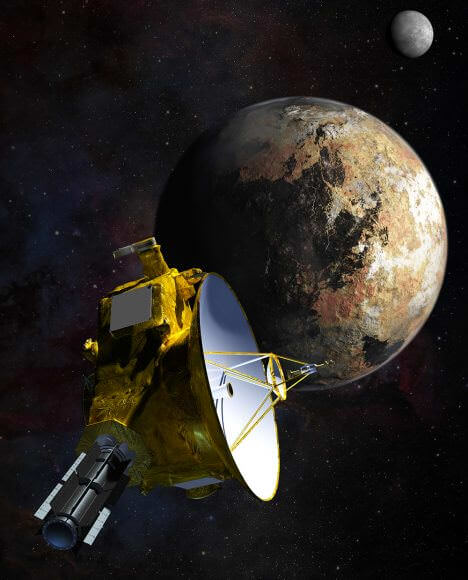Once held to be the outermost planet of the Solar System, Pluto‘s designation was changed by the International Astronomical Union in 2006, owing to the discovery of many new Kuiper Belt Objects that were comparable in size. In spite of this, Pluto remains a source of fascination and a focal point of much scientific interest. And even after the historic flyby conducted by the New Horizons probe in July of 2015, many mysteries remain.
What’s more, ongoing analysis of the NH data has revealed new mysteries. For instance, a recent study by a team of astronomers indicated that a survey by the Chandra X-ray Observatory revealed the presence of some rather strong x-rays emissions coming from Pluto. This was unexpected, and is causing scientists to rethink what they thought they knew about Pluto’s atmosphere and its interaction with solar wind.
In the past, many Solar bodies have been observed emitting x-rays, which were the result of interaction between solar wind and neutral gases (like argon and nitrogen). Such emissions have been detected from planets like Venus and Mars (due to the presence of argon and/or nitrogen in their atmospheres), but also with smaller bodies like comets – which acquire halos due to outgassing.
Artist’s impression of New Horizons’ close encounter with the Pluto–Charon system. Credit: NASA/JHU APL/SwRI/Steve Gribben
The last time Pluto was at perihelion was on September 5th, 1989, which means that it was still experiencing summer when NH made its flyby. While studying Pluto, the probe detected an atmosphere that was primarily composed of nitrogen gas (N²) along with methane (CH4) and carbon dioxide (CO²). Astronomers therefore decided to look for signs of x-ray emissions coming from Pluto’s atmosphere using the Chandra X-ray Observatory.
Prior to the NH mission’s flyby, most models of Pluto’s atmosphere expected it to be quite extended. However, the probe found that the atmosphere was less extended and that its rate of loss was hundreds of times lower than what these models predicted. Therefore, as the team indicated in their study, they expected to find x-ray emissions that were consistent with what the NH flyby observed:
“Given that most pre-encounter models of Pluto’s atmosphere had predicted it to be much more extended, with an estimated loss rate to space of ~1027 to 1028 mol/sec of N² and CH4… we attempted to detect X-ray emission created by [solar wind] neutral gas charge exchange interactions in the low density neutral gas surrounding Pluto,” they wrote.
Images sent by NASA’s New Horizons spacecraft show possible clouds floating over the frozen landscape including the streaky patch at right. Credit: NASA/JHUAPL/SwR
But the energy distribution they noted with Pluto’s x-rays were not consistent with this explanation. Another possibility that the team offered is that they could be due to some process (or processes) that focus the solar wind near Pluto, which would enhance the effect of its modest atmosphere. As they indicate in their conclusions:
“The observed emission from Pluto is not aurorally driven. If due to scattering, it would have to be sourced by a unique population of nanoscale haze grains composed of C, N, and O atoms in Pluto’s atmosphere resonantly fluorescing under the Sun’s insolation. If driven by charge exchange between [solar wind] minor ions and neutral gas species (mainly CH4) escaping from Pluto, then density enhancement and adjustment of the [solar wind] minor ion relative abundance in the interaction region near Pluto is required versus naïve models.”For the time being, the true cause of these x-ray emissions is likely to remain a mystery. They also highlight the need for more research when it comes to this distant and most massive of Kuiper Belt Objects. Luckily, the data provided by the NH mission is likely to be poured over for decades, revealing new and interesting things about Pluto, the outer Solar System, and how the most distant worlds from our Sun behave.
The study – which was accepted for publication in the journal Icarus – was conducted by astronomers from the Johns Hopkins University Applied Physics Laboratory (JHUAPL), the Harvard-Smithsonian Center for Astrophysics, the Southwest Research Institute (SwI), the Vikram Sarabhai Space Center (VSCC), and NASA’s Jet Propulsion Laboratory and Ames Research Center.
Further Reading: CfA, arXiv
The post Did you Know There are X-rays Coming from Pluto? That’s Strange, What’s Causing it? appeared first on Universe Today.


No comments:
Post a Comment